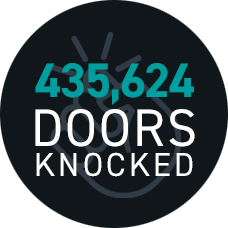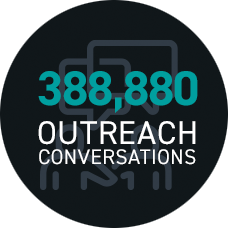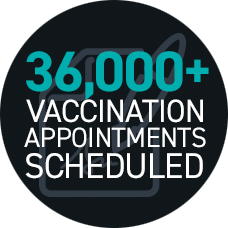In 2021, GroundWorks began partnering with several public agencies to reach out to Californians in communities hard-hit by the COVID pandemic. As it turns out, GroundWorks’ traditional electoral organizing methods relying on high-quality person-to-person contact are perfectly suited to this work, allowing us to educate hundreds of thousands of people, connect them with vaccination, testing and services, and literally save lives.



When the COVID pandemic hit in 2020, Californians from all walks of life and in every community suffered its impacts, but not everyone suffered equally. Some communities, often lower-income communities and communities of color, suffered higher rates of infection, faced steeper barriers in securing testing, healthcare and vaccination and struggled with more profound economic impacts including experiencing higher rates of hunger and homelessness as the pandemic dragged on. In this context, both the State of California and the County of Santa Clara, among many other public entities, determined to reach out directly to Californians who were most hard-hit to improve rates of testing and vaccination, connect people with public services and provide one-on-one personal support. But how to reach the people who needed it most? And who would do the reaching out? GroundWorks answered the call!
GroundWorks became a key player in the statewide Healthy Future California (HFCA) Vaccination Project, a collaboration between labor and community groups to provide education and sign people up for vaccination in targeted low-income communities of color where people were deeply and disproportionately affected by pandemic. Beginning in April of 2021, the project incorporated traditional person-to-person electoral “Get Out the Vote” (GOTV) contact strategies to “Get Out the Vaccine” door-knocking and phone banking. Organizers on this campaign did phone banking and knocking on doors, worked in multiple languages and had a personal stake in the work as they overwhelmingly lived in the same communities where they were doing outreach. The results statewide? GroundWorks’ teams had 1:1 personal conversations with over 300,000 Californians and scheduled 29,320 vaccination appointments during the darkest days of the pandemic.
During the same time period, GroundWorks teams joined a similar collaborative effort in Santa Clara County, knocking on doors and calling residents in hard-hit neighborhoods to sign them up for testing and vaccination and providing “concierge service” to make it easier for residents to get vaccinated. Instead of taking “no” or “I’m not sure” for an answer at the door when offering vaccination appointments, GroundWorks organizers asked “What do you need?” or “How can we help?”. The work in Santa Clara County evolved as more and more people were vaccinated and the teams moved to addressing other needs related to the economic impacts of the pandemic – signing people up for rental and food assistance as well as referring to other county programs. The results in this one county? GroundWorks teams had 1:1 conversations with almost 65,000 people, scheduled 6,799 vaccination appointments and connected nearly 2,000 households with much-needed services to keep them housed and nourished.
Through the experience of the pandemic, we learned again a lesson we’ve known all along at GroundWorks: traditional electoral tools and strategies can be repurposed to do community outreach for the public good at scale and it works! Between these two state and county programs in 2021, GroundWorks organizers made over 4 million phone calls and knocked on over 400,000 doors producing personal, impactful conversations with over 388,000 Californians and scheduling over 36,000 people to be vaccinated. We believe this proves the point that disciplined, accountable and targeted one-on-one organizing strategies are a good use of public resources to improve people’s quality of life, create opportunities for people to grow as organizers and activists in their own communities, and save lives when the stakes are highest.

